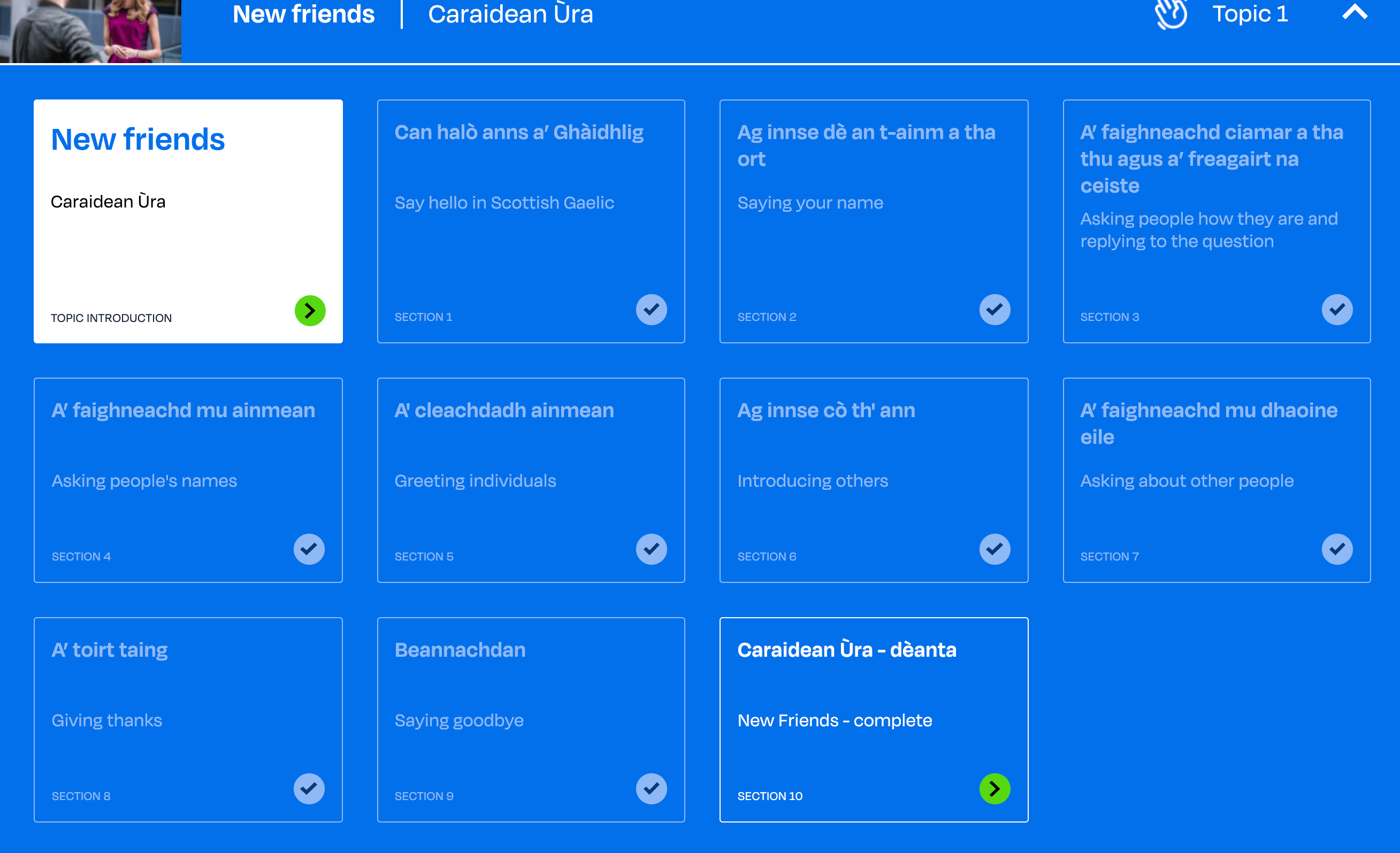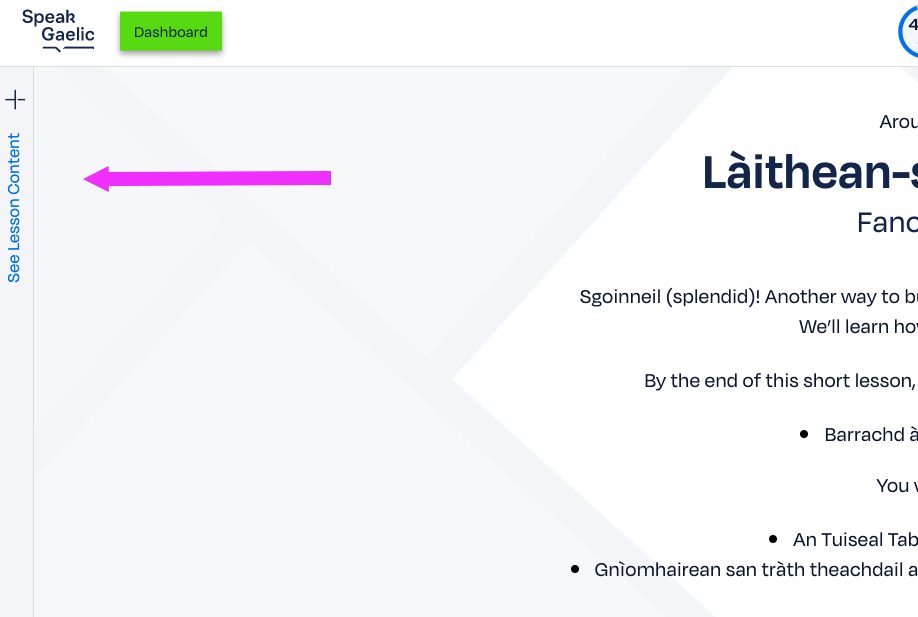Eacarsaich chànain
Language exercise
Here’s an extra task. It’s not mandatory!
If you have a Gaelic speaking/learning friend, you could do this together. If you don’t—no problem—you can have double the fun!
Read the following article about the second dinosaur which has a Gaelic name. It’s from the BBC Naidheachdan website.
You’ll find some of the new vocabulary below.
It doesn’t matter if you didn’t understand the whole piece.
It’s important to read Gaelic at different levels.
And you’ll find the translation below—taing do shealbh (thank goodness!)!
Fhuaireadh am fosail pterosaur as motha riamh san Eilean Sgitheanach
Chaidh am fosail pterosaur as motha riamh bhon Linn Diùrasaich fhaighinn san Eilean Sgitheanach ‘s chaidh ainm Gàidhlig a thoirt air—Dearc Sgitheanach.
Tha an cnàmhlach a chaidh fhaighinn ann an 2017 le Comann Nàiseanta a’ Chruinn–eòlais ann an staid fìor mhath – chìthear gu follaiseach na fiaclan aige mar ràsar ‘son a bhith a’ gearradh agus ag ithe.
Bhiodh sgiathan 2.5m air a’ chreutair agus bha iad beò mu 170 millean bliadhna air ais.
Tha e a–nise ann an Taigh–Tasgaidh Nàiseanta na h–Alba far an tèid barrachd rannsachaidh a dhèanamh air le luchd–saidheans bhon taigh–tasgaidh fhèin, is cuideachd bho Oilthigh Dhùn Èideann, Cill Rìmhinn, Taigh–Tasgaidh Stafainn, agus Taigh–Tasgaidh an Hunterian ann an Glaschu.
A’ sgrìobhadh anns an iris Current Biology thuirt oileanach PhD aig Oilthigh Dhùn Èideann, Natalia Jagielska, gu bheil an dearc a’ sealltainn gu bheil pailleon–eòlas na rud a tha daonnan iongantach.
‘ ‘S ann ainneamh a chìthear pterosauran ann an staid cho math seo ‘s mar as trice ‘s ann ann am Braisil no Sìona a thathas gan lorg. Ach ‘s ann air cladach an Alba a fhuaireas am fear seo,’ thuirt i.
‘S ann aig Rubha nam Bràthairean a chaidh an dearc a lorg agus Amelia Penny a’ faicinn peirceall a’ tighinn a–mach às a’ chlach–aoil.
Le Dùghall Ros bho Thaigh–Tasgaidh Stafainn os cionn chùisean, fhuair iad air an pterosaur a thoirt às a’ chreig le a bhith a’ cleachdadh sàbh–daoimean ‘s cabhag orra seo a dhèanamh mus tigeadh an làn a–steach.
Bidh luchd–saidheans a–nise a’ coimhead air mar a dheigheadh aig an dearc a bhith a’ sgèith ‘s ciamar a bha e beò.
A rèir luchd–saidheans bhiodh na creutairean seo a’ fàs cho mòr ri itealan cogaidh a chithear an–diugh, mus deach iad à bith.
fosail (f)
fossil
cnàimhneach [cnàmhlach] (m)
skeleton, skeletal remains
clach–aoil (f)
limestone
millean (m)
million
Diùrasach (adj)
Jurassic
pailleon–eòlas (m)
palaeontology
ràsar (m)
razor
dearc (f)
reptile, animal, berry, speckled fish!
peirceall (m)
jaw
chaidh à bith
became extinct
Ciamar a chaidh dhut?
The largest ever pterosaur fossil from the Jurassic Age was found in the Isle of Skye and it has been given a Gaelic name: Dearc Sgitheanach.
The skeleton which was found in 2017 by the National Geographic Society is in a very good condition—the razor–like teeth for cutting and eating can be seen clearly.
The creature would have had a wingspan of 2.5m and they lived about 170 million years ago.
It is now in the National Museum of Scotland where more research will be carried out on it by scientists from the museum itself, and also the Universities of Edinburgh and St Andrews, Staffin Museum and the Hunterian Museum in Glasgow.
Writing in the periodical Current Biology, PhD student at Edinburgh University Natalia Jagielska said that the lizard shows that palaeontology is something which is always surprising.
‘It’s rare to see pterosaurs in such a good condition [a condition as good as this], and usually it’s in Brazil or China that they are found. But it’s on the shores of Scotland that this one was found,’ she said.
It was at Rubha nam Bràthairean [Brothers’ Point] that the lizard was found when Amelia Penny saw a jaw poking out of the limestone.
With Dugald Ross from Staffin Museum in charge, they got the pterosaur out of the rock by using a diamond saw, in a rush to do this before the tide came in.
Scientists will now be looking at how the lizard was able to fly and how it lived.
According to scientists, these creatures would grow as big as a warplane that can be seen today, before they became extinct.
Are you desperate for more? Go to 24B Duilleag Obrach where you’ll find some questions on this article.




